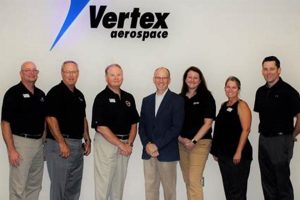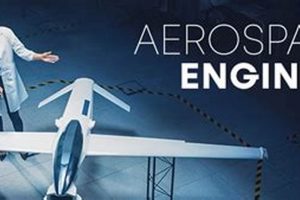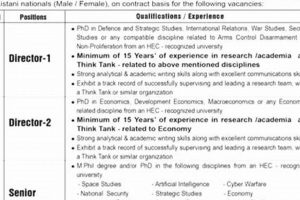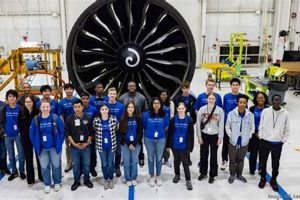Positions suitable for recent graduates or individuals with limited professional experience in the field of aircraft and spacecraft design, development, and manufacturing within the state of California represent a significant segment of the employment landscape. These opportunities typically involve supporting senior engineers in various tasks, such as conducting research, performing simulations, and assisting with the testing and analysis of aerospace systems. For example, a role might entail using CAD software to create detailed models of aircraft components under the guidance of a more experienced design engineer.
Securing a starting role in this domain offers numerous advantages, including invaluable practical experience, the chance to apply theoretical knowledge gained during academic studies, and the establishment of professional networks within a cutting-edge industry. Historically, California has been a hub for aerospace innovation and production, making it a prime location for individuals seeking to launch their careers in this sector. The concentration of aerospace companies in the state ensures a relatively high demand for skilled engineers, including those at the beginning of their professional journey.
The subsequent sections will delve into specific areas within this career path, exploring typical job duties, required qualifications, and the types of companies that commonly offer these roles. Furthermore, information regarding salary expectations and resources for finding relevant employment opportunities will be provided.
The competitive landscape demands a strategic approach. Successfully securing a position requires meticulous preparation, targeted networking, and a thorough understanding of industry expectations.
Tip 1: Cultivate a Strong Academic Foundation: Emphasis on core aerospace engineering principles, such as aerodynamics, propulsion, and structural analysis, is crucial. Seek out opportunities for advanced coursework and relevant projects during undergraduate studies.
Tip 2: Gain Practical Experience Through Internships: Participation in internships at aerospace companies or research institutions provides invaluable hands-on experience and exposure to industry practices. Prioritize internships that align with specific career interests.
Tip 3: Develop Proficiency in Relevant Software: Mastery of industry-standard software, including CAD (e.g., SolidWorks, CATIA), CAE (e.g., ANSYS, ABAQUS), and programming languages (e.g., MATLAB, Python), is highly desirable. Consider pursuing certifications to demonstrate competency.
Tip 4: Build a Professional Network: Active participation in industry events, conferences, and professional organizations, such as the American Institute of Aeronautics and Astronautics (AIAA), facilitates networking with potential employers and industry professionals.
Tip 5: Tailor the Resume and Cover Letter: Customization of application materials to align with the specific requirements of each job posting is essential. Highlight relevant skills, experiences, and achievements that demonstrate suitability for the role.
Tip 6: Prepare for Technical Interviews: Technical interviews often involve problem-solving scenarios and questions related to fundamental engineering principles. Practice answering common technical questions and be prepared to discuss past projects in detail.
Tip 7: Research Potential Employers: A thorough understanding of a company’s products, services, and culture demonstrates genuine interest and enhances the candidate’s ability to articulate their fit within the organization.
Adherence to these guidelines can significantly increase the likelihood of securing employment in the competitive California aerospace sector, propelling professional advancement within the field.
The subsequent discussion will explore typical career trajectories following initial employment in entry-level positions and strategies for long-term professional growth.
1. Education Requirements
The attainment of a relevant educational qualification constitutes a fundamental prerequisite for securing roles in California’s aerospace engineering sector. Specifically, a Bachelor of Science degree in Aerospace Engineering or a closely related field, such as Mechanical Engineering with a concentration in aerospace, is almost universally mandated. The curriculum of these programs equips candidates with the foundational knowledge of aerodynamics, propulsion, structures, and control systems essential for success in such positions. For example, entry-level design engineers often rely on principles learned in their undergraduate fluid dynamics courses to analyze airflow around aircraft components.
While a Bachelor’s degree provides a sufficient foundation for many initial positions, a Master’s degree in Aerospace Engineering can significantly enhance career prospects and open doors to more specialized roles and higher starting salaries. Master’s programs allow for in-depth exploration of specific areas, such as computational fluid dynamics, composite materials, or spacecraft design. Furthermore, internships or research experiences gained during both undergraduate and graduate studies are highly valued by employers. These experiences provide practical application of theoretical knowledge and demonstrate a candidate’s commitment to the field. For instance, participation in a university-sponsored rocket design competition can provide invaluable hands-on experience that aligns directly with the skills sought by many aerospace companies.
In summary, strong academic qualifications are critical for obtaining starting roles within the aerospace engineering industry in California. A Bachelor’s degree serves as a baseline requirement, with a Master’s degree providing a competitive advantage. Furthermore, practical experience gained through internships and research opportunities strengthens a candidate’s application and better prepares them for the challenges of the profession. The emphasis on formal education reflects the complex and highly technical nature of aerospace engineering and the need for a strong foundation of scientific and engineering principles.
2. Key Skills
Possessing a specific set of competencies is paramount for individuals seeking entry-level positions in the aerospace engineering sector in California. These skills bridge the gap between academic knowledge and practical application, enabling recent graduates to contribute effectively from the outset.
- Proficiency in CAD/CAE Software
Computer-Aided Design (CAD) and Computer-Aided Engineering (CAE) tools form the backbone of modern aerospace design and analysis. Mastery of software packages such as SolidWorks, CATIA, ANSYS, and ABAQUS is often a prerequisite. For example, an entry-level structural analyst might use ANSYS to simulate stress distributions within an aircraft wing component designed in CATIA. Lacking these skills severely limits an applicant’s competitiveness.
- Understanding of Aerospace Fundamentals
A solid grasp of fundamental aerospace principles, including aerodynamics, propulsion, structures, and control systems, is essential. Applicants should be able to apply these concepts to practical engineering problems. For example, understanding Bernoulli’s principle is crucial for analyzing lift generation in airfoil design, a common task for entry-level aerodynamicists. A weak grasp of these basics will hinder problem-solving abilities.
- Programming and Data Analysis Skills
The ability to program in languages such as MATLAB or Python, and to analyze data using statistical methods, is increasingly important. These skills are used for tasks such as flight simulation, data processing from wind tunnel experiments, and analyzing sensor data from flight tests. For example, an entry-level engineer might use Python to automate the processing of large datasets generated during a computational fluid dynamics simulation. Inability to manipulate and interpret data efficiently diminishes effectiveness.
- Problem-Solving and Critical Thinking
Aerospace engineering frequently presents complex challenges requiring strong problem-solving and critical-thinking skills. The ability to identify problems, analyze potential solutions, and make informed decisions is highly valued. For example, an entry-level engineer might be tasked with troubleshooting a malfunctioning sensor on a test aircraft. The capacity to think critically and apply logical reasoning is fundamental.
These key skills, while diverse, collectively define the profile of a competitive candidate for entry-level aerospace engineering positions in California. Demonstrating proficiency in these areas significantly enhances an applicant’s chances of securing employment and contributing meaningfully to the industry. Possessing these abilities translates to increased productivity and greater value to potential employers in this highly competitive market.
3. Company Landscape
The structure and composition of the aerospace industry in California exert a direct and significant influence on the availability and nature of starting positions for engineers. The concentration of major aerospace corporations, alongside smaller specialized firms and research institutions, creates a diverse ecosystem that shapes career trajectories. The presence of companies such as Boeing, Lockheed Martin, Northrop Grumman, and SpaceX, for example, directly correlates with the number of available roles. A downturn in defense spending or a shift in priorities at a major contractor can reduce hiring, while the growth of commercial space ventures increases demand for specific skill sets. Each company’s specific product lines and technological focus dictate the type of expertise sought in new hires.
Moreover, the size and organizational structure of each entity impact the roles and responsibilities assigned to engineers in entry-level positions. Large corporations may offer structured rotational programs, providing exposure to different aspects of the business, while smaller companies typically provide greater autonomy and opportunity for early involvement in significant projects. Understanding this landscape is crucial for job seekers. Targeting companies whose projects align with personal interests and skillsets increases the likelihood of a successful application. Identifying emerging trends and the companies driving these changes allows for proactive skill development to meet future industry demands. Knowing, for example, that a company is heavily involved in developing advanced composites for aircraft structures would suggest the need to develop skills in composite material design and analysis.
In summary, the California aerospace company landscape is a critical determinant of opportunities for newly qualified engineers. Analyzing this landscape enables a strategic job search, allowing candidates to focus on companies aligned with their skills and career goals. The dynamics of this landscape, including company growth, technological advancements, and market trends, necessitate ongoing awareness to effectively navigate and succeed within the industry. Successful career planning hinges on understanding how broader industry forces shape the availability and nature of starting opportunities within this vital sector.
4. Salary Expectations
The consideration of compensation is a fundamental aspect when evaluating entry-level aerospace engineering employment opportunities in California. Salary expectations represent a critical element in the overall attractiveness and viability of these positions. Remuneration levels serve as a direct indicator of the perceived value and demand for specific skill sets within the industry. The offered salary affects an individual’s ability to manage living expenses, repay educational debts, and build financial security, particularly in a high-cost-of-living region like California. For instance, an offer significantly below the market average may necessitate foregoing the opportunity despite interest in the specific job duties or company.
A realistic understanding of prevailing salary ranges enables job seekers to effectively negotiate compensation packages. Online resources such as Glassdoor and Salary.com provide data on average salaries for entry-level aerospace engineers in different California locations, though such figures should be considered as indicative benchmarks rather than definitive values. Factors such as the specific company, the engineer’s educational background, and relevant experience gained through internships can all influence the final negotiated salary. Moreover, benefits packages, including health insurance, retirement plans, and paid time off, should be factored into the overall evaluation of a job offer. The absence of comprehensive benefits may necessitate a higher base salary to offset potential out-of-pocket expenses.
In summary, salary expectations play a crucial role in the decision-making process for individuals pursuing entry-level aerospace engineering careers in California. A thorough understanding of market rates, combined with effective negotiation skills, ensures fair compensation that reflects the value of the engineer’s contributions. Failing to adequately address this aspect can lead to dissatisfaction and potentially hinder long-term career progression within the industry. Consequently, a balanced assessment of salary and benefits is paramount when weighing employment opportunities in this competitive sector.
5. Geographic Distribution
The concentration of aerospace companies within specific regions of California significantly influences the accessibility and distribution of starting opportunities for engineers. Proximity to major aerospace hubs directly impacts the availability of positions and career progression pathways.
- Southern California Dominance
The majority of positions are located in Southern California, encompassing Los Angeles, Orange County, and San Diego. This region houses major aerospace corporations and defense contractors, resulting in a higher concentration of job opportunities relative to other areas of the state. Entry-level engineers seeking employment should prioritize locations within this geographical area.
- Bay Area Presence
The San Francisco Bay Area, while not as dominant as Southern California, features a growing presence of aerospace companies, particularly those focused on commercial space ventures and innovative technologies. Companies like SpaceX (though primarily based in Southern California, it maintains a Bay Area presence) and various satellite technology firms contribute to opportunities in this region. Engineers with expertise in software development and advanced materials may find opportunities within the Bay Area’s unique aerospace ecosystem.
- Cost of Living Considerations
The geographic distribution of opportunities is intrinsically linked to the cost of living in these regions. Southern California and the Bay Area have some of the highest living expenses in the nation. Entry-level engineers must factor in housing costs, transportation expenses, and general living costs when evaluating job offers in these areas. Salary expectations should be adjusted accordingly to ensure financial stability.
- Impact on Career Mobility
The concentration of aerospace companies in specific regions affects career mobility. Engineers who begin their careers in Southern California or the Bay Area may find it easier to transition between companies and pursue promotions due to the density of potential employers. Geographic proximity to industry events, professional organizations, and networking opportunities also enhances career development prospects. Geographic isolation can hinder advancement and limit exposure to new technologies and industry trends.
The described geographic distribution underscores the importance of location in the pursuit of starting positions in California’s aerospace industry. Strategic consideration of these factors is essential for maximizing career opportunities and ensuring financial well-being.
Frequently Asked Questions about Entry Level Aerospace Engineering Jobs in California
This section addresses common inquiries and clarifies essential aspects related to securing initial employment in California’s aerospace engineering sector. It aims to provide concise, fact-based answers to pertinent questions.
Question 1: What minimum educational qualification is typically required for starting positions?
A Bachelor of Science degree in Aerospace Engineering or a closely related field, such as Mechanical Engineering with an aerospace concentration, is generally the minimum requirement. Some employers may prefer candidates with a Master’s degree.
Question 2: What are the most crucial technical skills that employers seek in entry-level candidates?
Proficiency in CAD/CAE software (e.g., SolidWorks, CATIA, ANSYS), a solid understanding of aerospace fundamentals (aerodynamics, propulsion, structures), and programming skills in languages like MATLAB or Python are highly valued.
Question 3: Which geographic areas in California offer the highest concentration of opportunities?
Southern California, including Los Angeles, Orange County, and San Diego, is the primary aerospace hub. The San Francisco Bay Area also presents opportunities, particularly in commercial space ventures.
Question 4: What is a realistic salary expectation for individuals with limited experience?
Salaries vary depending on location, company size, and specific skill sets. Researching industry benchmarks using resources like Glassdoor and Salary.com is recommended to establish a realistic expectation. Cost of living should also be factored into this determination.
Question 5: How important are internships in securing initial employment?
Internships are highly valuable and significantly enhance a candidate’s prospects. Practical experience gained through internships provides a competitive advantage and demonstrates applied knowledge.
Question 6: What strategies can be employed to increase the likelihood of securing a position?
Cultivating a strong academic foundation, gaining practical experience through internships, developing proficiency in relevant software, building a professional network, and tailoring application materials are essential strategies.
Understanding these key aspects contributes to a more informed and strategic approach to job searching and career planning.
The subsequent section will provide resources for finding relevant employment opportunities and further information about career development in the aerospace industry.
Concluding Observations on Entry Level Aerospace Engineering Jobs California
This exploration has presented a detailed overview of securing entry level aerospace engineering jobs california. Critical factors, including the requisite educational background, essential technical skills, prevailing salary expectations, and the geographical concentration of opportunities, have been addressed. The importance of strategic preparation, targeted networking, and proactive skill development has been emphasized. The intent is to provide prospective engineers with the knowledge necessary to navigate the competitive job market effectively.
The information presented herein serves as a foundation for informed decision-making. Aspiring aerospace engineers are encouraged to leverage these insights to strategically position themselves for success and contribute to the continued advancement of the aerospace industry within California. A commitment to continuous learning and adaptation to evolving industry demands remains paramount for long-term career growth and fulfillment.







